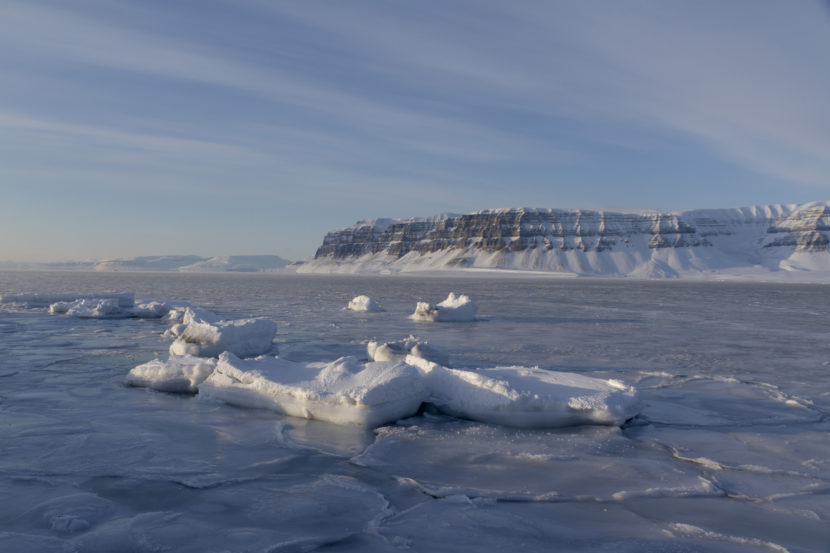
2016 was not a good year for the Arctic with the continued warming of the air and sea water, and diminishing sea ice.
The National Oceanic and Atmospheric Administration on Tuesday released its Arctic Report Card for 2016. Jeremy Mathis is director of NOAA’s Arctic Research Program and an editor of the 106-page report.
It was the warmest year on record for the Arctic where the average air temperature is increasing at twice the rate as the global average.
This year was 6.3 degrees Fahrenheit hotter than 1900. Also, water temperatures in the Arctic were 9 degrees Fahrenheit higher than the recent average.
“The report card this year clearly shows a stronger and more-pronounced signal of persistent warming than any previous year in our observational record,” Mathis said. “Those warming effects in the Arctic have had a cascading effect through the environment, including down into Arctic ecosystems.”
Topping the list of the warmth’s cascading effects is this fall’s slow freeze-up and continued decline of the Arctic ice pack.
The minimum Arctic sea ice extent in October tied for the second lowest since the beginning of satellite observations in 1979.
Thinner, more-fragile first-year ice now makes up the overwhelming majority of the Arctic ice pack, compared with 30 years ago when it was roughly a half-and-half mix with thicker, stronger, multi-year ice.
Dartmouth College’s Donald Perovich, another of the report’s editors, said the Arctic ice pack could recover if temperatures cool. But he doesn’t think it’s likely.
“What we’re seeing right now is the first act of a three-act play,” Perovich said. “We’re seeing the fall freeze-up has been very slow, and we have a record minimum ice extent. Act 2 will come in March when we see what the maximum is. And, Act 3 of course will be in September. I kind of await that with both anticipation and a little bit of concern.”
It’s hard to predict when the Arctic Ocean will be ice-free in the summer or what the Arctic will look like in 10 years. But Mathis said Arctic communities should be concerned about diminishing access to subsistence resources.
“It’s getting harder and harder for them to harvest resources as the ice pulls back further and further away from the coast,” Mathis said. “That’s a place where we need to be focusing our attention and our efforts to help them either continue to find those food sources and to rely on those food sources. Or, think about ways that we can help them deal with the loss or the decline of the food sources.”
Mathis said one positive aspect of less sea ice and earlier melting is that it stimulates more growth of phytoplankton, the base of the marine food web.
“But, at the same time, that primary productivity is the mechanism in which carbon dioxide is moved from the atmosphere into the ocean, and that’s what ocean acidification is,” Mathis said. “So, we already see a rapid progression of ocean acidification in the Arctic. And, that seems to be accelerating as the ice melts back further and further and productivity increases.”
Watch a short video presentation about the Arctic Report Card 2016:
The Arctic Report Card also notes a shrinking Greenland ice sheet, and spring snow cover dropped to a record low in the American and Canadian Arctic.
Columbia University’s Marco Tedesco said the amount of snow melt affects hydropower production and fresh water reserves.
“But, also, it’s impacting the ecosystems around it. The snow melting sooner and faster is leaving a drier soil exposed to a warmer summer,” Tedesco said. “So, you might have more jobs. You might have more forest fires. So, this might have, of course, ramifications for the economy, for the population.”
Melting permafrost can also affect infrastructure development or construction in the far north.
Watch the news conference on Tuesday about the Arctic Report Card 2016 at the annual meeting of the American Geophysical Union in San Francisco:
The warming, largely greening tundra is now releasing more carbon than it is taking in, and scientists are worried that the immense amounts of carbon stored in the melting permafrost could eventually be released and alter weather and climate around the globe.
“It’s a reminder of what I think many of us in Alaska feel is happening right before our eyes. And, that the Arctic is changing so dramatically,” Margaret Williams said after reviewing the Arctic Report Card. Williams is with the World Wildlife Fund in Anchorage
Williams doesn’t think it’s too late to take action on climate change.
“At the state level, every state can make a difference on the policies on energy efficiency and conservation,” Williams said. “Then, as individuals, people can also make a difference in how they manage their own personal carbon footprint.”
This is the 11th year for the Arctic Report Card, a peer-reviewed report sponsored by NOAA that includes the work of more 60 scientists from 11 countries. The findings were presented Tuesday at the annual meeting of the American Geophysical Union in San Francisco.
Matt Miller is a reporter at KTOO in Juneau.




